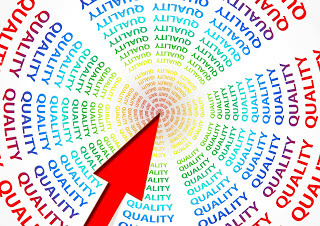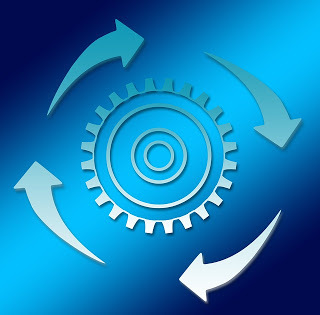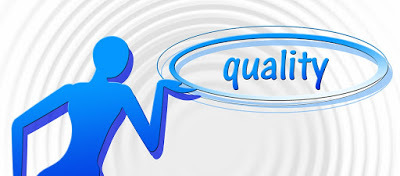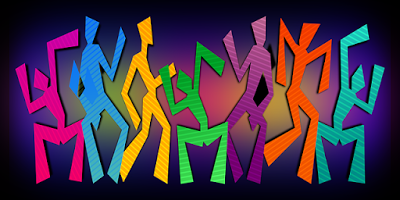Pearl Zhu's Blog, page 1361
February 26, 2016
Talent Management Monthly Brief: See Through Talent from Different Angles IV Feb. 2016
 People are always the most invaluable asset in businesses. “Hiring the right person to the right position at the right time,” is the mantra of many forward-thinking organizations. The question is how would you define the right people? How do you define wrong, average, mediocre, good, great or extraordinary person? Or put simply, for what should they be right? Traditional Performance Management focusing on measuring what an employee does (mainly being told to do) in quantitative way is not sufficient to identify high performance or high potential, should we see through talent from different angles?
People are always the most invaluable asset in businesses. “Hiring the right person to the right position at the right time,” is the mantra of many forward-thinking organizations. The question is how would you define the right people? How do you define wrong, average, mediocre, good, great or extraordinary person? Or put simply, for what should they be right? Traditional Performance Management focusing on measuring what an employee does (mainly being told to do) in quantitative way is not sufficient to identify high performance or high potential, should we see through talent from different angles?
See Through Talent from Different Angles Three Questions to Assess a Person’s Advancement Are you an analytical or synthetic thinker? An intuitive or a logical thinker? Are you a critical and independent thinker or the conventional thinker (following conventional wisdom) Etc. To put simply, we are what we think of. Perception is based on one’s thought processes which are influenced by one’s thinking style, cognitive understanding, and knowledge level. As a matter of fact, the way we think has much of an effect on how we deal with problems, and turn out in our life (though many other things do as well). Some examples might be, who we surround ourselves with, how hard we try to do certain things, whether or not we're repetitive, the communication styles, the career preferences, or the hobbies and entertainment choice, etc.
Three Questions to Assess an Employee’s “Balance” Digital is all about the balance: the balance of the physical and the virtual world; the balance of innovation and standardization; the balance of unconventional insight and accumulated human wisdom. From talent management perspective, should you also assess the “balance” capability of an employee? Surely we don’t expect all employees have gymnast's balance skills, so what does digital balance mean for today’s digital professionals? And what are thought-provoking questions to evaluate their “balance” ability?
Three Questions to Assess an Employee’s Authenticity: Most of the employees at pyramidal organizations in the industrial age are like cogs in the huge mechanical business wheel, keep working, but lack the big picture about the strategic goals of their organizations as well as lack the imagination about their own potential. Now the new digital paradigm that is emerging is one of a living organization, one that is organic, alive, energetic, fluid, connected and holistic. Every staff is also like a living “cell,” can continue to discover and grow, creative and influential. So an important perspective for either talent managers or employees themselves is to ask tough questions and discover authenticity and purpose of the work, to unleash the collective human potential and business potential as well.
How to Assess a Person’s Intelligence: "Intelligence" is from Latin word “intellego” -Inter-lego: Bind together, read between the lines, or connect the dots. Intelligence has been defined in many different ways such as in terms of one's capacity for logic, abstract thought, understanding, self-awareness, communication, learning, emotional knowledge, memory, planning, creativity and problem solving. Intelligence is indeed multidimensional, so how to assess a person’s “intelligence”?
Three Questions to Evaluate a Person’s Perception? Perception is the way you understand someone or something. It is as we see, observe and experience as defined by our mental "band-pass filters." Our mind notices and recognizes some things, but may not do the same for some other things. Our perception is what makes up our worldview, and how do we articulate and convey from what we “see” or understand. Perception is one's interpretation of the reality. So it is very subjective and varies from person to person. How to evaluate a person’s perception, though?
 The “Future of CIO” Blog has reached 1.3+million page views with about #2500+ blog posting in 59+ different categories of leadership, management, strategy, digitalization, change/talent, etc. blog posting. The content richness is not for its own sake, but to convey the vision and share the wisdom, to inspire critical thinking and spur healthy debates. Blogging is not about writing, but about thinking and innovating the new ideas; it’s not just about WHAT to say, but about WHY to say, and HOW to say it. It reflects the color and shade of your thought patterns, and it indicates the peaks and curves of your thinking waves. Unlike pure entertainment, quality and professional content takes time for digesting, contemplation and engaging, and therefore, it takes time to attract the "hungry minds" and the "deep souls." It’s the journey to amplify diverse voices and deepen digital footprints, and it's the way to harness your innovative spirit.
The “Future of CIO” Blog has reached 1.3+million page views with about #2500+ blog posting in 59+ different categories of leadership, management, strategy, digitalization, change/talent, etc. blog posting. The content richness is not for its own sake, but to convey the vision and share the wisdom, to inspire critical thinking and spur healthy debates. Blogging is not about writing, but about thinking and innovating the new ideas; it’s not just about WHAT to say, but about WHY to say, and HOW to say it. It reflects the color and shade of your thought patterns, and it indicates the peaks and curves of your thinking waves. Unlike pure entertainment, quality and professional content takes time for digesting, contemplation and engaging, and therefore, it takes time to attract the "hungry minds" and the "deep souls." It’s the journey to amplify diverse voices and deepen digital footprints, and it's the way to harness your innovative spirit.
See through talent from different angles Jan. 2016See through talent from different angles Dec. 2015See through talent from different angles Nov. 2015Follow us at: @Pearl_Zhu
Published on February 26, 2016 23:22
Three Questions to Assess a Person’s “Decisiveness”
 At today’s digital dynamic with increased velocity, complexity, unpredictability, there is a need for a faster response to changes in business and industry based on effective and efficient decision making which is one of the most important tasks for both digital leaders and digital professionals at either strategic, operational, or tactical level. How is that possible? What’s the digital way to make the right decision? And how to assess a person’s “decisiveness”?
At today’s digital dynamic with increased velocity, complexity, unpredictability, there is a need for a faster response to changes in business and industry based on effective and efficient decision making which is one of the most important tasks for both digital leaders and digital professionals at either strategic, operational, or tactical level. How is that possible? What’s the digital way to make the right decision? And how to assess a person’s “decisiveness”?
Do you have a decisive mindset with data enriched and information empowered? The decision-maker must have enough knowledge to make their decisions rich in information and significantly different from the available data. Decisions are based on information and generate information. The amount of data required for a decision, and the amount of information generated by a decision, can both be measured in bits. Thus, a decisive mindset is data enriched and information empowered. Sometimes even an analytical mind can be distorted by self-interest, emotional attachments, or misleading memories. Just implementing an analytics tool is not going to result in improved decision making for an organization. The technology should be seen as an enabler and should form part of an analytics strategy, but not be its whole. Improved decision making will only come when insights from the analytics system are directly matched to improved decisions and better outcomes.
What’s your decision making styles: Decision making in itself is a complex and simple process based on the probable effect of the decision on the outcome of the organizational goal. The decision-making style should be based on the situation: Are you a “timer” who can make an on-time, quick decisions? Or are you an “expressor” who can collect different point of views and leverage them to make effective decisions? Etc. One of the prerequisites of decision making is to recognize your own frame of reference prior to making any decision. If you do not recognize the lens through which you make sense of the world around, you are unknowingly captive to your own predispositions. Achieving such awareness through serious self-reflection, frees you from the habitualized 'scripts,' and allows you to see new possible options before decisions are made. Hence, collecting necessary information is an important step in making an objective decision.Decision power is a mind-power; it guides what to select from available choices, how to accommodate constraints, how to avoid distractions, and where to show firmness and flexibility. Decision power is knowledge-based, wisdom-driven, and character-oriented.
 How well can you deal with paradox of decision making? The paradox of decision is that sometimes you have to sacrifice to save and sometimes you have to disable one thing to enable another. Decision-making is an ability that is learned or unlearned and can swing both ways (making decisions or avoiding) depending mostly on upbringing and cultural circumstances. Often the decision making challenges include: When are the options too close to each other in similarity? Is the outcome of each option either unclear or undesirable, etc. Human knowledge is imperfect about multiple choices and the related outcomes. The Knowledge constraint is a paramount issue during the decision process. But decisions are needed at every moment of life; it cannot be postponed till the availability of complete knowledge. The deficiency of knowledge is overcome through decision power.
How well can you deal with paradox of decision making? The paradox of decision is that sometimes you have to sacrifice to save and sometimes you have to disable one thing to enable another. Decision-making is an ability that is learned or unlearned and can swing both ways (making decisions or avoiding) depending mostly on upbringing and cultural circumstances. Often the decision making challenges include: When are the options too close to each other in similarity? Is the outcome of each option either unclear or undesirable, etc. Human knowledge is imperfect about multiple choices and the related outcomes. The Knowledge constraint is a paramount issue during the decision process. But decisions are needed at every moment of life; it cannot be postponed till the availability of complete knowledge. The deficiency of knowledge is overcome through decision power.
In the world of uncertainty, the decisive mind can, by definition, not control the outcome, however, focus on making good decisions and the best chance for a good outcome is to make a good decision. The biggest challenge is knowing what you don't know, it is a reasonable moniker for decision making blind spots and biases. Hence, good judgment is a must for good decisions, data analysis and inferences from such data. A good decision needs to use both intuitive mind and rational analysis. A good decision maker is information-empowered, analytics oriented, and striking the right balance between confidence and humility, logic and creativity; thinking big & thinking small; thinking fast & thinking slow, and often they are great problem solver as well.
Follow us at: @Pearl_Zhu
Published on February 26, 2016 23:17
Three Things Differentiate Digital Masters from Laggards
 Digital transformation is a journey. Although is is on every forward-looking organization’s agenda, they may take different levels of altitude, attitude, and aptitude to achieve it. There are three levels of digital maturity, level one digital laggards often have skeptical attitude about the radical change and have very limited advanced digital capability, and pretty much still running with structured silos at the industrial speed. Level 2 digital mediocrity take a conservative mindset or attitude to move with digital speed. And level 3 digital masters (less than 15%) of overall businesses are digital forerunners who are courageous to be in the vanguard of digital transformation with a quantum lead, they also develop the set of advanced and unique digital capabilities and build a digital premium into the very foundation of the business. More specifically, what are important things differentiate digital master from digital laggards?
Digital transformation is a journey. Although is is on every forward-looking organization’s agenda, they may take different levels of altitude, attitude, and aptitude to achieve it. There are three levels of digital maturity, level one digital laggards often have skeptical attitude about the radical change and have very limited advanced digital capability, and pretty much still running with structured silos at the industrial speed. Level 2 digital mediocrity take a conservative mindset or attitude to move with digital speed. And level 3 digital masters (less than 15%) of overall businesses are digital forerunners who are courageous to be in the vanguard of digital transformation with a quantum lead, they also develop the set of advanced and unique digital capabilities and build a digital premium into the very foundation of the business. More specifically, what are important things differentiate digital master from digital laggards?
Leadership difference: Digital leadership is the unique combination of leadership behaviors that develops and achieves high quality and meaningful results over a sustained period of time. Digital leadership can be described as "adaptability meets agility.” At today’s “digital dynamic with VUCA” (Velocity, Uncertainty, Complexity, and Ambiguity) characteristics, Being thoughtful, mindful and multi-dimensional thinker is more crucial to improve leadership effectiveness. Digital leaders need to be more original, positive, progressive, courageous, conscious, creative and curious, and to adopt mindsets of not knowing, challenging convention, maximizing diversity and being willing to experiment, as a basis for then being able to think differently, independently, and globally. The next skill level up is mental agility, adaptive capacity. Then you can add on influence, such as persuasive skills, motivational skills, political skills, decision-making skills, interpersonal skills, conflict management skills, and finally conceptual skills.
Strategy proficiency: VUCA (volatility, uncertainty, complexity and ambiguity) is a digital new normal, as complexity and uncertainty increasing, the connection between any single individual organization’s strategy, and their tactical plans and actions can become diluted and disconnected. You can develop a strategic plan based on the improvement of the real situation by analyzing the mandate and extract policies that enable you to make the vision and missions, then to make the smart objectives, policies, and programs that solve your developments problems. Digital strategy needs to be more dynamic in order to capture the emergent opportunities - Admit that disruptive events may occur. Learn to stay alert and to observe with subtlety and learn fast.It’s about agile strategy-execution cycle. It's not all about "making a strategy" as end-product, but about implementing it afterward. It is also about communicating about the quality of the strategy, saying openly what is known and what is not. To "be opportunistic" could also be expressed as stay curious, especially for the unexpected; even the unwanted - in order to recognize the emergence of the completely new phenomenon. Making a strategy in times of uncertainty and unpredictability is an interesting way of putting things right, "plan, but be able to adapt quickly to current realities. The greater that conditions of uncertainty prevail, the more likely it is that the final strategy will be a product of emergent thinking rather than the original formulation. Digital Masters concentrate on the objectives of your organization and make sure that the roles and functions are stated perfectly.
 IT as a revenue growth engine: IT can drive the business but it should be in conjunction with the business. IT and the CIO can apply their knowledge of technology to propose products, services, offerings, new ways of doing things, etc. to the business, to run IT as a business that contributes to the revenue growth. The de facto best practices of managing IT project portfolio need to include such as, only manage business projects, not for technology's sake, prioritize the portfolio, and manage the full application life cycle in a continuous mode. For example, if App Dev can't keep up with the demand and pace of business change, then there are problems. But AppDev should not innovate simply to amuse itself; and it's wasteful of resources, money, effort in many companies. From AppDev to potential application retirement, with the right methodology (either Agile, DevOp., etc), talent and metrics, to catch up with the speed of business changes without sacrificing the quality.
IT as a revenue growth engine: IT can drive the business but it should be in conjunction with the business. IT and the CIO can apply their knowledge of technology to propose products, services, offerings, new ways of doing things, etc. to the business, to run IT as a business that contributes to the revenue growth. The de facto best practices of managing IT project portfolio need to include such as, only manage business projects, not for technology's sake, prioritize the portfolio, and manage the full application life cycle in a continuous mode. For example, if App Dev can't keep up with the demand and pace of business change, then there are problems. But AppDev should not innovate simply to amuse itself; and it's wasteful of resources, money, effort in many companies. From AppDev to potential application retirement, with the right methodology (either Agile, DevOp., etc), talent and metrics, to catch up with the speed of business changes without sacrificing the quality.
\Digital maturity matters, the small percentage of Digital Masters can stretch out in every business dimension for driving the full-fledged digital transformation to adapting to the new world of the business: Faster, always “on,” high connected and super competitive. The philosophy and methodology that digital masters use can be selectively adopted by any company that has the digital leadership drive to do so. It requires strong leadership to drive changes, a vision for why and a dynamic planning on how you want to get there, from doing digital to being digital.
Follow us at: @Pearl_Zhu
Published on February 26, 2016 23:15
February 25, 2016
The Weekly Insight of the “Future of CIO” 2/26/2016
 The “Future of CIO” Blog has reached 1.3 million page views with 2500+ blog posting in 59+ different categories of leadership, management, strategy, digitalization, change/talent, etc. The content richness is not for its own sake, but to convey the vision and share the wisdom. Here is the weekly insight about digital leadership, IT Management and Talent Management.
The “Future of CIO” Blog has reached 1.3 million page views with 2500+ blog posting in 59+ different categories of leadership, management, strategy, digitalization, change/talent, etc. The content richness is not for its own sake, but to convey the vision and share the wisdom. Here is the weekly insight about digital leadership, IT Management and Talent Management.
The Weekly Insight of the “Future of CIO” 2/26/2016How to Maximize IT Value Business paradigm is shifting from the industrial era to an information/digital era, IT plays a pivotal role in such a transformation: the business needs IT to deliver services / solutions that drive productivity and effectiveness; the business wants fit-for-purpose IT solutions that enable them to be efficient in delivering services and products to their market at the right cost to deliver profits to the shareholders. Business needs IT to provide better information as a nervous system to the business for improving profitability. Businesses are also looking for IT to add new innovative methods for complexity management, data transformation, quality improvement and agile construction etc. But, how can IT meet so many expectations and maximize IT value to achieve long-term business goals?
Three Principles for Communication Effectiveness: Communication is always important, although it is the means to the end, not the end itself. The end is for problem solving and idea brainstorming. A great communicator doesn’t need to be “the everyone’s tea,” but in order to communicate effectively and avoid the miscommunication symptoms such as “lost in translation,” you have to follow the right set of principles and deliver the messages persuasively and creatively.
Five Traits of High Quality IT Professionals People are always the weakest link in any organization, this is particularly true for IT organizations due to the changing nature and complexity of technologies. IT skills gap is a significant challenge facing IT leaders today, the common complaints from talent managers include: people do not have the right competencies; they can’t find the right skills to fill the positions or their non-IT partners do not understand IT, etc. Are such problems an organization specific, or systematic? what are exactly the skills gaps and what are the resulting symptoms? What are the emergent traits to be high-quality IT professionals regardless of the specific skills, how to reinvent "IT geek" stereotype and build a healthy and positive IT culture for catalyzing innovation?
Agility vs. Flexibility: Agility is the ability of a business to adapt rapidly and cost efficiently in response to changes in the business environment. Agile provides greater flexibility and it requires great discipline especially at team member level. Great power comes with great reasonability.
 A Leadership Journey from Good to Great. The reason the great leadership being so rare is that people are more often conditioned throughout education to be followers, to conform, only one right answer, etc. The industrial age required followers, those, including some being put in a leadership position, that would just do their jobs and not to question. However, we are not in the industrial age any longer. On one hand, now at a digital age, there are many informal leaders - who practice professional influence via digital channels - throughout organizations, industry and beyond. More digital leaders are emerging via their power of positive influence; not the title of status quo. On the other hand, digital also raises the bar to be a great leader, because everything becomes so transparent, leadership is no longer just about a few spotlight moments, but a continuous learning and delivery; leadership is also no long only about what you talk, what you act, but about what you think - the thought processes can be much easily tracked down via your digital footprint, so how can you take an ongoing leadership journey from good to great?
A Leadership Journey from Good to Great. The reason the great leadership being so rare is that people are more often conditioned throughout education to be followers, to conform, only one right answer, etc. The industrial age required followers, those, including some being put in a leadership position, that would just do their jobs and not to question. However, we are not in the industrial age any longer. On one hand, now at a digital age, there are many informal leaders - who practice professional influence via digital channels - throughout organizations, industry and beyond. More digital leaders are emerging via their power of positive influence; not the title of status quo. On the other hand, digital also raises the bar to be a great leader, because everything becomes so transparent, leadership is no longer just about a few spotlight moments, but a continuous learning and delivery; leadership is also no long only about what you talk, what you act, but about what you think - the thought processes can be much easily tracked down via your digital footprint, so how can you take an ongoing leadership journey from good to great? Blogging is not about writing, but about thinking and innovating the new ideas; it’s not just about WHAT to say, but about WHY to say, and HOW to say it. It reflects the color and shade of your thought patterns, and it indicates the peaks and curves of your thinking waves. Unlike pure entertainment, quality and professional content takes time for digesting, contemplation and engaging, and therefore, it takes time to attract the "hungry minds" and the "deep souls." It’s the journey to amplify diverse voices and deepen digital footprints, and it's the way to harness your innovative spirit.
Follow us at: @Pearl_Zhu
Published on February 25, 2016 23:09
Three Questions to Evaluate a Person’s Perception
 Perception is one's interpretation of the reality. It’s the way you understand someone or something. It is as we see, observe and experience as defined by our mental "band-pass filters," our mind notices and recognizes some things, but may not do the same for some other things. Our perception is what makes up our worldview, and how do we articulate and convey from what we “see” or understanding. Perception is one's interpretation of the reality, so it is very subjective and varies from person to person. So how to evaluate a person’s perception?
Perception is one's interpretation of the reality. It’s the way you understand someone or something. It is as we see, observe and experience as defined by our mental "band-pass filters," our mind notices and recognizes some things, but may not do the same for some other things. Our perception is what makes up our worldview, and how do we articulate and convey from what we “see” or understanding. Perception is one's interpretation of the reality, so it is very subjective and varies from person to person. So how to evaluate a person’s perception?
What’s your “default thought process and thinking style? Are you an analytical or synthetic thinker? An intuitive or a logical thinker? Are you a critical and independent thinker or the conventional thinker (following conventional wisdom) Etc. To put simply, we are what we think of. Perception is based on one’s thought processes which are influenced by one’s thinking style, cognitive understanding, and knowledge level. As a matter of fact, the way we think has much of an effect on how we deal with problems, and turn out in our life (though many other things do as well). Some examples might be, who we surround ourselves with, how hard we try to do certain things, whether or not we're repetitive, the communication styles, the career preferences, or the hobbies and entertainment choice, etc.
Are you often make a fair judgment based on your perception, or the opposite is true? Our perception is, in turn, an interpretation based on our conditioning or beliefs etc, leading us to judge others, all of which may be positive or negative, depending on one's perception. In effect, our perception is always flawed, it is not absolutely true, but it is what we believe to be true. Most of people like to label thing, perhaps via subconscious cognition. Labeling is not necessarily the problem, it’s misjudging that is problematic. Labels can be bad or misleading, but they aren't inherently so. It's the judging part that is problematic. It's when a label carries negative connotations, and drives bipolar or extreme thinking that might cause the problems and make misjudgment. The challenge is to try and not judge something or someone as good or bad, or wrong or right, or black or white. And everybody is different because everyone has a different personality, life goals, priority setting, living styles and time management skills. etc.
 Are you a digital literate with a continuous learning habit to consciously update your perceptions for things you are not sure, or people you do not have in-depth understanding? Because out of dated perception is like time glue that keeps you still while the rest of the world moves on which creates another problem- resentment and more negative thinking. Perception only affects how you interact with the world. One’s perception matters because it affects on how you are going to respond to “what happened.” What "really" happened is irrelevant. It is only your perception of what happened that is relevant, and therefore how you are going to respond to "what happened." The digital literate is not the one who cannot read or write, but the one who can’t learn, delearn and relearn.
Are you a digital literate with a continuous learning habit to consciously update your perceptions for things you are not sure, or people you do not have in-depth understanding? Because out of dated perception is like time glue that keeps you still while the rest of the world moves on which creates another problem- resentment and more negative thinking. Perception only affects how you interact with the world. One’s perception matters because it affects on how you are going to respond to “what happened.” What "really" happened is irrelevant. It is only your perception of what happened that is relevant, and therefore how you are going to respond to "what happened." The digital literate is not the one who cannot read or write, but the one who can’t learn, delearn and relearn.
Everyone has bias, even the eldest still has very limited life experience, and the wisest only understands the tip of iceberg of the world. Perception is the way our eyes see the world. It can be shaped by our biased thinking and also by the environment around us. The reality is the result of what a group of people agrees to call real. Perception differs, according to what an individual or a group is able to understand this common reality. Having learning attitude allows you gaining cognizant of the different perceptions of the world, and having gratitude allows you being more positive and gives you the energy to overcome obstacles
Follow us at: @Pearl_Zhu
Published on February 25, 2016 23:06
CIOs as Change Agent: Five Perils of Changes Management
 Change is the only constant, and the speed of change is increasing rapidly. Organizations large or small spend significant time and resource to deal with the bbg changes such as radical digital transformation or small changes such as adopting a new version of software. And statistically, more than 70% of Change Management effort fail to achieve the expected result, what are the perils of Change management, and how to manage change more effectively?
Change is the only constant, and the speed of change is increasing rapidly. Organizations large or small spend significant time and resource to deal with the bbg changes such as radical digital transformation or small changes such as adopting a new version of software. And statistically, more than 70% of Change Management effort fail to achieve the expected result, what are the perils of Change management, and how to manage change more effectively?
Silo Mentality: Silo mentality is a common challenge for lots of organizations. Even businesses steps into the hyper-connected digital world, many business managers still apply old silo management mindsets to new ways of organizing, and this legacy of the old economy limits many 'networked' organizations. Are silos a mere product of organizational design? Or is it tied to a deeper humankind's nature? In today's volatile economy, nothing impedes progress more than protective silos which are simply a form of bureaucratic amorphous mass designed to preserve the status quo. Despite the mountain of evidence pointing the detrimental effects of these silos, they still seem to be quite common in organizations. In essence, with silo mentality, organizations lose their collaborative advantage as they are being over managed and under led, remain disconnected, hoard knowledge and power within silos, and do not have the competence to collaborate in the long term. When leaders of an organization place an emphasis on building a culture of cross-functional collaboration, the opportunity for silos to work against the alignment of all departments towards the goals and objectives of the organization is diminished.
Fixing the symptom, not cure the root causes: Often times, the management teams have a tendency to try to fix a symptom which results from the actual cause of the problem. When they do this, they throw good money after bad. They allow problems to grow under the surface, out of sight, out of mind, until it’s too late. The company is trying to fix a symptom, not the real problem which is stifling staff creativity, communication, and productivity. Until the underlying problem is addressed, the symptom or result will continue to return. So trying to fix the wrong cause of a problem will waste time and resources, increase anxiety, and leave industries full of opportunists that see long-term rewards by offering solutions that address symptoms and results rather than problems. A better solution that crosses all industries is to keep peeling back the layers to find the root cause via asking five WHYs, or taking other systematic approaches - to discover the real cause, and address it, to make change sustanable.
Change inertia: As the saying going, "people don't resist change, they resist being changed." Prevention of "R"(resistance) is what most people call "good leadership." There are two types of resistances are expected: personal level and structural layer, and both need to be addressed effectively and efficiently. If someone is "resisting" change, what's that about? Are they perhaps interested in "certainty," "stability," "think things are on the right path" or is it something else? It's a good idea to get clarity on what the "resistance" is all about and look closer to the reality of what's going on. Change is inevitable, and the only differences are the reasons and goals behind the change and its scope, depth and breadth (Why to change, what you need to accomplish, what does it consist of and what does it impact). Overall, good anticipation in planning is key for a smoother execution, while over-communication, regular updates and plan adjustments will enhance your chances of success.
Multifaceted complexity: Organizations "become complex," not for their own amusement, they do it to respond to environments more proactively. There are many shades of corporate complexity, some are desired such as design or connectivity, others are not. The self diagnosis questions include: Is there a selection of complexity dynamics at play which therefore lead one to think that organizations are becoming more complex, which lead better agility or less? Are they increasing in hierarchical complexity because they need to coordinate more cross-functionally? Are they increasing in information density complexity because of advance in technology and information processing? Are they increasing in network complexity because of the number of nodes and connections in the organizational environment? Within the organizational context, it seems to be useful to separate complication from complexity. The complicated things can be simplified in a certain way, but the desired complexity can become business’s competency because the competitors cannot copy such capability easily. The very effort of change management is to enforce the fair complexity, and eliminate redundancy and complication.
 Ineffective change management: Unclear communication for vision, goals, the need of change, benefits of change and each one's role in the change is a huge mistake. The leaders need to be the change agent to walk the talk, to set the right tone for others to follow. Successful transformations require leaders to over-communicate the transformation vision. And now, social and enterprise collaboration tools do provide effective & interesting digital platform to make change more tangible and measurable. Change needs to have reasons: Remember no one like change especially when one can not identify the justification for the change. Change must be adopted and led by all of your first line managers if others are to follow you lead. Only through effective leadership, the change management needs to be well designed and practiced systematically.
Ineffective change management: Unclear communication for vision, goals, the need of change, benefits of change and each one's role in the change is a huge mistake. The leaders need to be the change agent to walk the talk, to set the right tone for others to follow. Successful transformations require leaders to over-communicate the transformation vision. And now, social and enterprise collaboration tools do provide effective & interesting digital platform to make change more tangible and measurable. Change needs to have reasons: Remember no one like change especially when one can not identify the justification for the change. Change must be adopted and led by all of your first line managers if others are to follow you lead. Only through effective leadership, the change management needs to be well designed and practiced systematically. There are both promises and perils in Change Management. The promises of effective change often leads the organization to the next level of agility and maturity. The perils of Change Management we discuss here can waste a lot of resources and cause a lot of pains. Change can not be just another thing that needs to be accomplished. It has to be woven into communication, process and action of the organization. In today's work environment. It takes a lot of energy to break habits and outdated thought processes, but change is happening at a more rapid pace. If you make change part of your routine, then change becomes easier to deal with, and even become a part of your DNA - the corporate culture.Follow us at: @Pearl_Zhu
Published on February 25, 2016 23:02
February 24, 2016
How to Leverage IT to Handle Digital Intensity?
 Organizations large and small are heading to digital transformation; IT has been pushed out of its comfort zone as back office and become a frontrunner in business transformation. Is IT ready or what’s the competitive advantage for IT to play such a critical role? Can IT play a significant role in handling the digital intensity, and ultimately become the business catalyst to drive changes?
Organizations large and small are heading to digital transformation; IT has been pushed out of its comfort zone as back office and become a frontrunner in business transformation. Is IT ready or what’s the competitive advantage for IT to play such a critical role? Can IT play a significant role in handling the digital intensity, and ultimately become the business catalyst to drive changes?
Strategy execution intensity: A finger without a hand is akin to a strategy without execution. A Strategy is a planned direction to act - without implementation, it is not complete and is probably someone's idea that got lost in the mail. IT is one of the most critical components to building business capabilities which underpin strategy execution. However, most companies are lacking a holistic strategy with IT strategy as an integral component on how they use technology to drive their business, and it's the information management strategy that most often goes unmanaged. Strategic Planning and Execution are a continuous cycle of organizational adaptation to a changing world. One of the factors for strategies to fail at the implementation phase is its complexity, and IT is the very tool to manage it and there is great value in collaborative technologies that allow for more democratic decision-making and increased collaboration and information sharing across functional departments. Digital technologies can also be very helpful in strategic analysis, and handle strategy execution intensity in a structural way.
Agile intensity: Forward-looking organization are shifting from “doing Agile” to “being Agile,” intensively. There are many things that need to be done to make a transition to a more agile way of working. Changes in the sizing and structuring of teams, their decision making, and team members’ levels of accountability and responsibility are just a few of the paradigm shifts you will encounter throughout the transition to Agile. Overall, it is a mindset change -Some mindset change is important up-front: There is a difference in agile thinking vs. conventional thinking, that behaviors which make you a hero in one culture may make you a pariah in the other. So the agile mentality is being “fearless”: And when fear is a driver for taking decisions, the next step is to use blame when things go wrong-- independently on the goodness of the behavior of the people involved. In many large-scale transitions to Agile development, fear has always been one of the major obstacles to change--fear of failure, fear of loss of control, etc. Hence, from doing agile to being agility, the digital intensity needs to be handled in the mindset level.
 Innovation intensity: Digital opens the new chapter of innovation, it is no longer “nice to have,” but “must have” business capability. Innovation is similar to as "the sum is larger than its parts." At today's modern organizations, variety, complexity, diversification, and collaboration are the characteristics of the digital innovation ecosystem. Innovation often implemented via technology is one main instrument to implement your company´s strategy. If you really innovate, you will differentiate your company at the same time. Innovation is costly most of the time, that is why you should really concentrate innovation on the main issues of your strategy - intensify innovation with focus. As you innovate, you might find helpful changes to your strategy. Further, organizations can no longer rely on a single individual or team to drive innovation. This is largely due to the fact that innovating in today’s digital world has become increasingly complex in nature. Innovation is intensified via complexity syndromes and the cause-effect scenario: Innovation will happen when people are given free space to be creative without rigid structures and without holding them back. In business, complexity both drives innovation and also hinders it. When a business becomes overly complex and people get frustrated and annoyed by not being able to accomplish things easily, this drives the search for simpler concepts and methods, which is the need to take the innovative initiative. At the same time, however, over-complexity in a business may be hiding simple and innovative ways to achieve things because the people involved just don't get the time to step back from the complexity and hence, they continue to follow the old routine to do the things, lack of the out of box creativity. Either way, IT is an enabler and the tool for innovation of the business.
Innovation intensity: Digital opens the new chapter of innovation, it is no longer “nice to have,” but “must have” business capability. Innovation is similar to as "the sum is larger than its parts." At today's modern organizations, variety, complexity, diversification, and collaboration are the characteristics of the digital innovation ecosystem. Innovation often implemented via technology is one main instrument to implement your company´s strategy. If you really innovate, you will differentiate your company at the same time. Innovation is costly most of the time, that is why you should really concentrate innovation on the main issues of your strategy - intensify innovation with focus. As you innovate, you might find helpful changes to your strategy. Further, organizations can no longer rely on a single individual or team to drive innovation. This is largely due to the fact that innovating in today’s digital world has become increasingly complex in nature. Innovation is intensified via complexity syndromes and the cause-effect scenario: Innovation will happen when people are given free space to be creative without rigid structures and without holding them back. In business, complexity both drives innovation and also hinders it. When a business becomes overly complex and people get frustrated and annoyed by not being able to accomplish things easily, this drives the search for simpler concepts and methods, which is the need to take the innovative initiative. At the same time, however, over-complexity in a business may be hiding simple and innovative ways to achieve things because the people involved just don't get the time to step back from the complexity and hence, they continue to follow the old routine to do the things, lack of the out of box creativity. Either way, IT is an enabler and the tool for innovation of the business.
in order to run IT with digital speed, IT needs to be at more proactive mode to not only solve the immediate problems for the bottom line but also handle more critical business issues which can directly impact business top line growth, and handle the multidimensional digital intensity seamlessly; IT talent should be not only tactical but also strategic, and IT is on the way to drive change, catalyze business growth and improve organizational efficiency, effectiveness and agility.
Follow us at: @Pearl_Zhu
Published on February 24, 2016 23:26
Five Traits of High Quality IT Professionals
 People are always the weakest link in any organization, this is particularly true for IT organizations due to the changing nature and complexity of technologies. IT skills gap is a significant challenge facing IT leaders today, the common complaints from talent managers include: people do not have the right competencies; they can’t find the right skills to fill the positions or their non-IT partners do not understand IT, etc. Are such problems an organization specific, or systematic? what are exactly the skills gaps and what are the resulting symptoms? And what are the emergent traits to be a high-quality IT professionals regardless of your specific skills?
People are always the weakest link in any organization, this is particularly true for IT organizations due to the changing nature and complexity of technologies. IT skills gap is a significant challenge facing IT leaders today, the common complaints from talent managers include: people do not have the right competencies; they can’t find the right skills to fill the positions or their non-IT partners do not understand IT, etc. Are such problems an organization specific, or systematic? what are exactly the skills gaps and what are the resulting symptoms? And what are the emergent traits to be a high-quality IT professionals regardless of your specific skills?
Cultivate “Thinking Habit”: Make thinking a habit is to compare, contrast, connect, create, choose with confidence! The technology keeps changing, and the information is overloading. Hence, IT professionals should be in a “continuously thinking mode,” not just doing something mechanically. For example, we all take shortcuts, make assumptions, and repeat erroneous generalizations. Therefore, Critical Thinking is important. Critical Thinking has more to do with how you process information, which is a complex mental activity that encompasses all aspects of one's cognitive styles, and the skills associated with critical thinking include exploring a problem from multiple perspectives, at the deeper level, it has creativity embedded in it. Analyzing the possibilities and projected outcomes provides an opportunity to apply Critical Thinking to the situation, Critical Thinking is a skill that has to be developed through a process, and continuous practices will shape it as a “Thinking Habit.”
Changeability and learning agility: By changing nature of technology, it’s not ok if people who are in the IT operations and think what they learned ten years back is sufficient for a lifetime. There are few and few “comfort zone” for IT professionals across industry sectors these days, because the speed of change is increasing, the knowledge life cycle is significantly shortened and the information is only a few clicks away at the age of digitalization. Also, the project development and management cycle is shortened based on Agile philosophy, and there are fewer multi-year projects, but shorter term app development to follow the principle of customer-centricity. It might sound like a cliche, the trick is understanding that moving out of a comfort zone leads to the creation of a new comfort zone which in turn will require you to move out "of" it again. This continuous moving "out" of your comfort zone is complemented by the cycle of self-development. Top IT performers are more adaptive and learning agile, and high-quality IT professionals need to be life-learners and change agents.
Creativity: Creativity is the #1 wanted skill for the digital workforce, this is particularly true for IT professionals because technology is often the innovation driver and IT professionals are innovation harbingers. Both information and technology are not for its own sake, but to discover the new and better way to do things, it’s the means to the end. The innovators are likely to make a change to the structure for better problem solving. The way we manage structure has a marked impact on how we deal with problems and the types of solutions we envisage. The IT workplace needs to be designed to build a culture of innovation, and help employees at all levels within an organization (from leaders to front-line) understand and develop their creative capacity to solve problems and exploit opportunities in new and innovative ways, the tool utilizes cutting-edge narrow band psychometrics to diagnose, assess and train the core four factors of creativity namely, cognitive processes, personality, motivation, and confidence..
 Problem-solving: While there are certainly a lot of IT people out there, there are a much smaller percentage who are really the "go-to" people, the ones who can work independently, have excellent problem-solving skills, are disciplined, have a "customer focus," and communicate well. Many IT specialists do not have enough knowledge and understanding about their businesses or customers, very few know their business’s strategy, and can’t map their daily tasks to the business’s strategic goal. Thus, it is no surprise that sometimes, instead of solving problems, they probably add more unnecessary complexity to the already tangled processes or products, to create the new problems. A high quality IT professional needs to be an excellent problem solver, who has the breadth of understanding of the business, the depth of technique expertise, and the creativity to see things from different angle to manage complexity and solve the problems in a systematic way, and the high-performing team with complementary skills can solve the complex problems collectively.
Problem-solving: While there are certainly a lot of IT people out there, there are a much smaller percentage who are really the "go-to" people, the ones who can work independently, have excellent problem-solving skills, are disciplined, have a "customer focus," and communicate well. Many IT specialists do not have enough knowledge and understanding about their businesses or customers, very few know their business’s strategy, and can’t map their daily tasks to the business’s strategic goal. Thus, it is no surprise that sometimes, instead of solving problems, they probably add more unnecessary complexity to the already tangled processes or products, to create the new problems. A high quality IT professional needs to be an excellent problem solver, who has the breadth of understanding of the business, the depth of technique expertise, and the creativity to see things from different angle to manage complexity and solve the problems in a systematic way, and the high-performing team with complementary skills can solve the complex problems collectively.
The capability portfolio: The business becomes more complex and dynamic, especially IT organizations, often the single-handed skill is not sufficient to adapt to changes. Just like IT is composed of hardware and software, IT professionals need to have both hard skills and soft competency, and the competency of high-quality IT professionals is a combination of capabilities with a focus. Each of these same capabilities may be combined in different fashions to yield multiple competencies. From the IT talent management perspective, there exist a stereotype about the skills set an individual is perceived to possess. But in the reality, there can be more or even less than expected. There are talent arenas such as synthetic capability, not very specific skills, can't be easily analyzed and hence, a recruiter fails in fitting right person to the job. They might even sometimes reject the correct person for the job based on the same stereotyped perception. From accumulating working experience (having X years experience or one-year experience X times) to sharpening linear skillset to building the nonlinear, but cohesive capability portfolio, IT professionals can improve digital proficiency and maturity.
IT skill gaps is reality. However, sometimes, the gaps people usually pick are not root causes they are symptoms of outdated talent management practices. It’s important to define the updated competency model, assess the talent's overall capability to solve problems, strike the right balance of hard and soft skills, learning capability, character, communication and energy within the teams. Getting the balance right is a must. Through recognize the truly high-quality IT professional (either high performer or high potential), IT can build a healthy culture to hire the right people to the right position, also building a high-performance team is at the heart of what talent manager should do and choose the right balance of team members is, as we all know, critical as well.Follow us at: @Pearl_Zhu
Published on February 24, 2016 23:23
February 23, 2016
CIO’s Digital Agenda XXXXII: How to Handle these IT Dilemmas to Run a Balanced IT?
 IT Management is a strange animal, in that the capabilities are there, the data is there - but the motivations are often confused. Technology drives changes nowadays, but IT is often considered the function slower to change with “controlling mentality.” IT tends to measure itself against trivial things IT considers important but are often less important and impactful in the business lens. More importantly, how to deal with the management dilemmas in running a balanced IT to improve the overall organizational maturity. How to Handle these IT Dilemmas to Run a Balanced IT?IT Transformation Debate: Shall IT Lead or Follow: More often than not, technology is the catalyst for driving business change and digital transformation, however, in most of the companies, IT is still perceived as an order taker and support function, and most of IT organizations get stuck at the lower level of maturity for functional alignment or enabler. So IT is at a crossroad: Shall IT lead or follow? Should IT leadership rock the boat or just keep it afloat? And how to run digital IT with high speed and agility?
IT Management is a strange animal, in that the capabilities are there, the data is there - but the motivations are often confused. Technology drives changes nowadays, but IT is often considered the function slower to change with “controlling mentality.” IT tends to measure itself against trivial things IT considers important but are often less important and impactful in the business lens. More importantly, how to deal with the management dilemmas in running a balanced IT to improve the overall organizational maturity. How to Handle these IT Dilemmas to Run a Balanced IT?IT Transformation Debate: Shall IT Lead or Follow: More often than not, technology is the catalyst for driving business change and digital transformation, however, in most of the companies, IT is still perceived as an order taker and support function, and most of IT organizations get stuck at the lower level of maturity for functional alignment or enabler. So IT is at a crossroad: Shall IT lead or follow? Should IT leadership rock the boat or just keep it afloat? And how to run digital IT with high speed and agility?
Shall a CIO be a General Manager of IT or a SME of all IT Domains? Today’s CIOs have multiple roles to play and take broader leadership responsibilities in transforming their organizations. Should a CIO be a general manager of IT or a subject matter expert (SME) of all IT domains?
Agile Dilemma: are Managers Happy, Developers are Unhappy or the Other Way Around Agile has emerged as the mainstream project management philosophy and methodology, does it make managers happy, developers unhappy, or the other way around, or ideally, can it make everyone happy as a fountain of improvement, interaction and incremental?
CIO’s Dilemma: Buy vs. Build There are many variables and considerations to the decision upon ‘build versus buy’. This decision is unique to each organization, industry, and application. There are pros and cons to each but regardless of which decision is taken, IT leaders need to make the case to successfully bring quality and speed with IT deliveries. Here are a few angles to see it through in order to make the right decisions.
IT Dilemma: Is Customer Always RIGHT: IT has always gone through this dilemma of "customers is always right" vs. "rational approach in designing a solution". If IT always see this as two conflicting forces pulling in opposite directions, you are most likely to get caught and always fall short of expectations. So what’s the right attitude in the face of such customer dilemma?
 The “Future of CIO” Blog has reached 1.3 million page views with 2500+ blog posting in 59+ different categories of leadership, management, strategy, digitalization, change/talent, etc. The content richness is not for its own sake, but to convey the vision and share the wisdom. Blogging is not about writing, but about thinking; it’s not just about WHAT to say, but about WHY to say, and HOW to say it. It reflects the color and shade of your thought patterns, and it indicates the peaks and curves of your thinking waves. Unlike pure entertainment, quality and professional content takes time for digesting, contemplation and engaging, and therefore, it takes the time to attract the "hungry minds" and the "deep souls." It’s the journey to amplify your voice, deepen your digital footprints, and match your way for human progression.Follow us at: @Pearl_Zhu
The “Future of CIO” Blog has reached 1.3 million page views with 2500+ blog posting in 59+ different categories of leadership, management, strategy, digitalization, change/talent, etc. The content richness is not for its own sake, but to convey the vision and share the wisdom. Blogging is not about writing, but about thinking; it’s not just about WHAT to say, but about WHY to say, and HOW to say it. It reflects the color and shade of your thought patterns, and it indicates the peaks and curves of your thinking waves. Unlike pure entertainment, quality and professional content takes time for digesting, contemplation and engaging, and therefore, it takes the time to attract the "hungry minds" and the "deep souls." It’s the journey to amplify your voice, deepen your digital footprints, and match your way for human progression.Follow us at: @Pearl_Zhu
Published on February 23, 2016 23:21
How to Assess a Person’s Intelligence
 "Intelligence" is from Latin word “intellego” -Inter-lego: Bind together, read between the lines, or connect the dots. Intelligence has been defined in many different ways such as in terms of one's capacity for logic, abstract thought, understanding, self-awareness, communication, learning, emotional knowledge, memory, planning, creativity and problem solving. Intelligence is indeed multidimensional, so how to assess a person’s “intelligence”?
"Intelligence" is from Latin word “intellego” -Inter-lego: Bind together, read between the lines, or connect the dots. Intelligence has been defined in many different ways such as in terms of one's capacity for logic, abstract thought, understanding, self-awareness, communication, learning, emotional knowledge, memory, planning, creativity and problem solving. Intelligence is indeed multidimensional, so how to assess a person’s “intelligence”?
What is your raw intelligence? Generally speaking, everybody has certain “raw intelligence,” independent of their formal education – an inherent intelligence and an area they're good at or even excel. All humans have their innate capabilities or intelligence: Just like a kind of tablet, one already completed and preserved inside you. Whether they are aware of it and can express it, or not, is a different question. intelligence is fluid, like fountainhead from within you, moving out. And such raw intelligence, just like the rough diamond can be sharpened, via continuous learning, to shape the differentiated capability which can be both useful to ourselves and benefit others as well.
What makes a person intellectual? In order to get "intelligence." a brain (a dynamic, evolving network of interconnected neurons) must have a certain minimum amount of complexity (complexity is a function of structure, the topology of that network of neurons, and entropy). What makes a person intellectual is the use of his/her intellect, which is the rational, analytical mind. When things are perceived intellectually, then they are looked at from the conscious mind and ordinary awareness, which means a quantifiable, logical, external perspective involving a lot of mental "doing" = thinking, comparing, concluding, reasoning and planning.intelligent, knowledgeable, articulate, and curious. It's how you think, and how others view your thoughts! Then, you need the intellectual integrity to use that knowledge wisely rather than for your own ends.
 How to apply intelligence to solving problems? It is our connectedness to the world around us that makes whatever intelligence we have truly useful to ourselves and to others; connected, by a sort of resonance between our cognitive and affective dimensions and the actual world we co-inhabit with those around us. The Intelligence is mainly comprised of two parts. The first part is the brain ability to preliminarily understand the extent of any problem or condition. The people with what being referred as highly intelligent have a strong aptitude to understand the "complexity" of the given problem. It's like a rating scale of complexity. Some people get the whole picture as opposed to others that can't seem to get a grasp on the problem. Now the second part to intelligence is the brain’s ability to call on as many neural circuits and work with as many areas in the brain it needs to solve the given problem.
How to apply intelligence to solving problems? It is our connectedness to the world around us that makes whatever intelligence we have truly useful to ourselves and to others; connected, by a sort of resonance between our cognitive and affective dimensions and the actual world we co-inhabit with those around us. The Intelligence is mainly comprised of two parts. The first part is the brain ability to preliminarily understand the extent of any problem or condition. The people with what being referred as highly intelligent have a strong aptitude to understand the "complexity" of the given problem. It's like a rating scale of complexity. Some people get the whole picture as opposed to others that can't seem to get a grasp on the problem. Now the second part to intelligence is the brain’s ability to call on as many neural circuits and work with as many areas in the brain it needs to solve the given problem. Intelligence is the quick and clear perception of any situation, plus ability to adjust to any circumstances. It is contextual and multidimensional. Whether someone is "intelligent" or not depends entirely on what you are asking them to accomplish with their brain. Intelligence is continuing with life no matter what, and never allow what you can't do interfere with what you can.Follow us at: @Pearl_Zhu
Published on February 23, 2016 23:17



